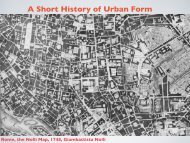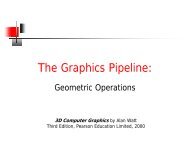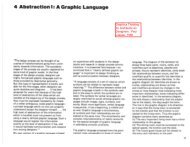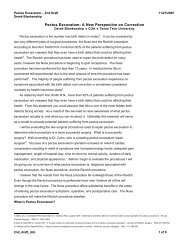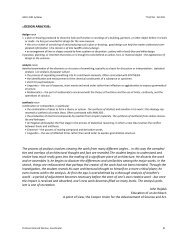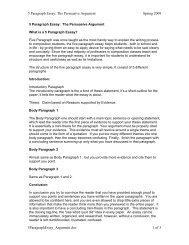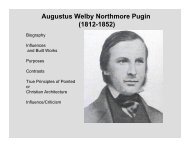The Eyes of the Skin
The Eyes of the Skin
The Eyes of the Skin
Create successful ePaper yourself
Turn your PDF publications into a flip-book with our unique Google optimized e-Paper software.
house. And <strong>the</strong> house which thus appears preserves all <strong>the</strong> ambiguity <strong>of</strong>real houses,' writes Sartre.139<strong>The</strong>re are cities that remain mere distant visual images when remembered,and cities that are rememberedin all <strong>the</strong>ir vivacity. <strong>The</strong> memoryre-evokes <strong>the</strong> delightful city with all its sounds and smells and variations<strong>of</strong> light and shade. I can even choose whe<strong>the</strong>r to walk on <strong>the</strong> sunny sideor <strong>the</strong> shaded side <strong>of</strong> <strong>the</strong> street in <strong>the</strong> pleasurablecity <strong>of</strong> my remembrance.<strong>The</strong> real measure <strong>of</strong> <strong>the</strong> qualities <strong>of</strong> a city is whe<strong>the</strong>rimagine falling in love in it.An Architecture <strong>of</strong> <strong>the</strong> Sensesone canVarious architectures can be distinguished on <strong>the</strong> basis <strong>of</strong> <strong>the</strong> sensemodality <strong>the</strong>y tend to emphasise. Alongside <strong>the</strong> prevailing architecture <strong>of</strong><strong>the</strong> eye, <strong>the</strong>re is a haptic architecture <strong>of</strong> <strong>the</strong> muscle and <strong>the</strong> skin. <strong>The</strong>reis architecture that also recognises <strong>the</strong> realms <strong>of</strong> hearing, smell and taste.<strong>The</strong> architectures <strong>of</strong> Le Corbusier and Richard Meyer, for instance,clearly favour sight, ei<strong>the</strong>r as a frontal encounter, or <strong>the</strong> kines<strong>the</strong>tic eye <strong>of</strong><strong>the</strong> promenade architecturale (even if <strong>the</strong> later works <strong>of</strong> Le Corbusier incorporatestrong tactile experiences in <strong>the</strong> forceful presence <strong>of</strong> materialityand weight). On <strong>the</strong> o<strong>the</strong>r hand, <strong>the</strong> architecture <strong>of</strong> <strong>the</strong> Expressionist orientation,beginning with Erich lVlendelsohn and Hans Scharoun, favoursmuscular and haptic plasticity as a consequence <strong>of</strong> <strong>the</strong> suppression <strong>of</strong>ocular perspectival dominance. Frank Lloyd \i\Tright's and Alvar Aalto'sarchitectures are based on a full recognition <strong>of</strong> <strong>the</strong> embodied humancondition and <strong>of</strong> <strong>the</strong> multitude <strong>of</strong> instinctual reactions hidden in <strong>the</strong>human unconscious. In today's architecture, <strong>the</strong> multitude <strong>of</strong> sensoryexperiences is heightened in <strong>the</strong> work <strong>of</strong> Glenn ]'vlurcutt, Steven Holland Peter Zumthor, for instance.Alvar Aalto was consciously concerned with all <strong>the</strong> senses in hisarchitecture. His comment on <strong>the</strong> sensory intentions in his furnituredesign clearly reveals this concern: 'A piece <strong>of</strong> furniture that forms apart <strong>of</strong> a person's daily habitat should not cause excessive glare fromlight reflection: ditto, it should not be disadvantageous in terms <strong>of</strong>sound, sound absorption, etc. A piece that comes into <strong>the</strong> most intimatecontact with man, as a chair does, shouldn't be constructed <strong>of</strong> materialsthat are excessively good conductors <strong>of</strong> heat.,Ho Aalto was clearlymore interested in <strong>the</strong> encounter <strong>of</strong> <strong>the</strong> object and <strong>the</strong> body <strong>of</strong> <strong>the</strong> userthan in mere visual aes<strong>the</strong>tics.Aalto's architectureexhibits a muscular and haptic presence. It incorporatesdislocations, skew confrontations, irregularities and polyrhythmsin order to arouse bodily, muscular and haptic experiences. His elaboratesurface textures and details, crafted for <strong>the</strong> hand, invite <strong>the</strong> sense <strong>of</strong>touch and create an atmosphere <strong>of</strong> intimacy and warmth. Instead <strong>of</strong> <strong>the</strong>disembodied Cartesian idealism <strong>of</strong> <strong>the</strong> architecture <strong>of</strong> <strong>the</strong> eye, Aalto'sarchitectureis based on sensory realism. His buildings are not based ona single dominant concept or gestalt; ra<strong>the</strong>r, <strong>the</strong>y are sensory agglomerations.<strong>The</strong>y sometimes even appear clumsy and unresolved as drawings,but <strong>the</strong>y are conceived to be appreciated in <strong>the</strong>ir actual physicaland spatial encounter, 'in <strong>the</strong> flesh' <strong>of</strong> <strong>the</strong> lived world, not as constructions<strong>of</strong> idealised vision.<strong>The</strong> Task <strong>of</strong> Architecture<strong>The</strong> timeless task <strong>of</strong> architectureis to create embodied and lived existentialmetaphors that concretise and structure our being in <strong>the</strong> world.Architecture reflects, materialises and eternalises ideas and images <strong>of</strong>ideal life. Buildings and towns enable us to structure, understand andremember <strong>the</strong> shapeless flow <strong>of</strong> reality and, ultimately, to recognise andremember who we arc. Architecture enables us to perceive and understand<strong>the</strong> dialectics <strong>of</strong> permanenceworld, and to place ourselves in <strong>the</strong> continuumand change, to settle ourselves in <strong>the</strong><strong>of</strong> culture and time.In its way <strong>of</strong> representing and structuring action and power, societaland cultural order, interaction and separation, identity and memory,70THE EYES OFTHE SKINPART 2 71




